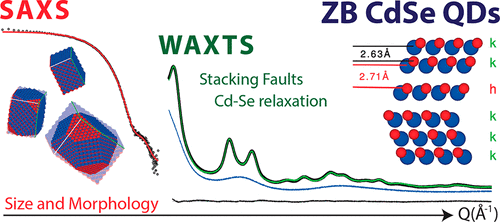Our official English website, www.x-mol.net, welcomes your feedback! (Note: you will need to create a separate account there.)
Size-Dependent Fault-Driven Relaxation and Faceting in Zincblende CdSe Colloidal Quantum Dots
ACS Nano ( IF 17.1 ) Pub Date : 2018-12-05 00:00:00 , DOI: 10.1021/acsnano.8b07092 Daniele Moscheni 1 , Federica Bertolotti 1, 2 , Laura Piveteau 3, 4 , Loredana Protesescu 3, 4 , Dmitry N. Dirin 3, 4 , Maksym V. Kovalenko 3, 4 , Antonio Cervellino 5 , Jan Skov Pedersen 6 , Norberto Masciocchi 1 , Antonietta Guagliardi 7
ACS Nano ( IF 17.1 ) Pub Date : 2018-12-05 00:00:00 , DOI: 10.1021/acsnano.8b07092 Daniele Moscheni 1 , Federica Bertolotti 1, 2 , Laura Piveteau 3, 4 , Loredana Protesescu 3, 4 , Dmitry N. Dirin 3, 4 , Maksym V. Kovalenko 3, 4 , Antonio Cervellino 5 , Jan Skov Pedersen 6 , Norberto Masciocchi 1 , Antonietta Guagliardi 7
Affiliation

|
Surface chemistry and core defects are known to play a prominent role in governing the photophysical properties of nanocrystalline semiconductors. Nevertheless, investigating them in small nanocrystals remains a complex task. Here, by combining X-ray scattering techniques in the wide- and small-angle regions and using the Debye scattering equation (DSE) method of analysis, we unveil a high density of planar defects in oleate-terminated zincblende (ZB) CdSe colloidal quantum dots (QDs) and size-dependent faceting within a square-cuboid morphology. Atomistic models of faulted ZB nanocrystals, based on the probabilistic stacking of CdSe layers in cubic and hexagonal sequences, and data analysis point to the preferential location of faults near the center of nanocrystals. By finely modeling faulting and morphological effects on the X-ray scattering pattern, a relaxation of the Cd–Se bond distance parallel to the stacking direction, up to +3% (2.71 Å) with respect to the reference bulk value (2.63 Å), is detected, at the cubic/hexagonal transitions. The smallest nanocrystals show cubic {100} facets; {111} facets appear above 4 nm and progressively extend at larger sizes. These structural and morphological features likely vary depending on the synthesis conditions; nevertheless, since planar defects are nearly ubiquitous in CdSe QDs, the modeling approach here presented has a general validity. This work also points to the great potential of combining small- and wide-angle X-ray scattering and DSE-modeling techniques in gaining important knowledge on atomic-scale defects of semiconductor nanocrystals, underpinning the comprehension of the impact of structural defectiveness on the exciting properties of these QDs.
中文翻译:

Zincblende CdSe胶体量子点中尺寸相关的故障驱动弛豫和刻面
已知表面化学和核心缺陷在控制纳米晶体半导体的光物理特性中起着重要作用。然而,研究它们在小的纳米晶体中仍然是一项复杂的任务。在这里,通过结合在广角和小角度区域的X射线散射技术并使用Debye散射方程(DSE)的分析方法,我们揭示了油酸盐封端的Znblende(ZB)CdSe胶体量子中的高密度平面缺陷点(QD)和正方形立方体形态内与尺寸有关的刻面。基于立方和六边形序列的CdSe层的概率堆积以及数据分析,基于断层的ZB纳米晶体的原子模型,并指出了断层在纳米晶体中心附近的优先位置。通过对X射线散射图样的断层和形态学效应进行精细建模,使Cd-Se键距平行于堆积方向的弛豫相对于参考体积值(2.63Å)达到+ 3%(2.71Å)在立方/六边形跃迁处检测到。最小的纳米晶体显示立方{100}晶面;{111}刻面出现在4 nm以上,并以更大的尺寸逐渐延伸。这些结构和形态特征可能会根据合成条件而有所不同。然而,由于平面缺陷在CdSe量子点中几乎无处不在,因此这里提出的建模方法具有普遍的有效性。这项工作还指出了将小角度和广角X射线散射技术与DSE建模技术相结合的巨大潜力,从而获得了有关半导体纳米晶体原子级缺陷的重要知识,
更新日期:2018-12-05
中文翻译:

Zincblende CdSe胶体量子点中尺寸相关的故障驱动弛豫和刻面
已知表面化学和核心缺陷在控制纳米晶体半导体的光物理特性中起着重要作用。然而,研究它们在小的纳米晶体中仍然是一项复杂的任务。在这里,通过结合在广角和小角度区域的X射线散射技术并使用Debye散射方程(DSE)的分析方法,我们揭示了油酸盐封端的Znblende(ZB)CdSe胶体量子中的高密度平面缺陷点(QD)和正方形立方体形态内与尺寸有关的刻面。基于立方和六边形序列的CdSe层的概率堆积以及数据分析,基于断层的ZB纳米晶体的原子模型,并指出了断层在纳米晶体中心附近的优先位置。通过对X射线散射图样的断层和形态学效应进行精细建模,使Cd-Se键距平行于堆积方向的弛豫相对于参考体积值(2.63Å)达到+ 3%(2.71Å)在立方/六边形跃迁处检测到。最小的纳米晶体显示立方{100}晶面;{111}刻面出现在4 nm以上,并以更大的尺寸逐渐延伸。这些结构和形态特征可能会根据合成条件而有所不同。然而,由于平面缺陷在CdSe量子点中几乎无处不在,因此这里提出的建模方法具有普遍的有效性。这项工作还指出了将小角度和广角X射线散射技术与DSE建模技术相结合的巨大潜力,从而获得了有关半导体纳米晶体原子级缺陷的重要知识,



























 京公网安备 11010802027423号
京公网安备 11010802027423号